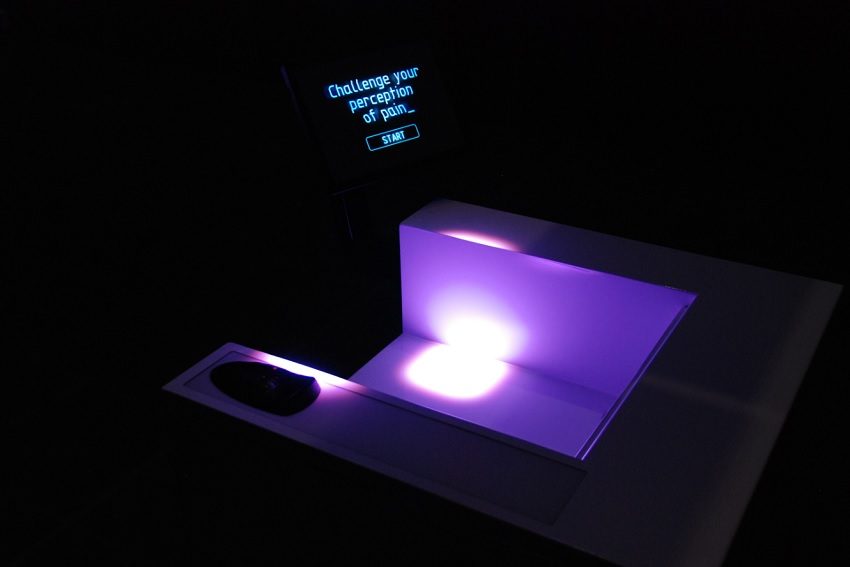Discovering the power of pain

A futuristic Adelaide exhibition highlights the neuroscience behind how we experience pain with hands on displays — including a pair of interactive pain chairs — at the Museum of Discovery (MOD).
Located on the first floor of UniSA’s Health Innovation Building on North Terrace, the MOD exhibit aims to improve our understanding of pain and to inspire greater interest in health science among young adults.
Featuring four interactive installations, visitors can learn about how our brains determine the level of pain we experience and explore what kind of pain is experienced under different conditions.
The concepts for the displays are drawn from the work of senior research fellows at UniSA, Dr Tasha Stanton and Professor Lorimer Moseley, in collaboration with various university staff and creatives. Stanton says that our experience of pain is not as simple as immediate trauma to our bodies and can be influenced by myriad emotional factors.
“Inherently, our experience of pain is a construct where our brain is taking in information from numerous different sources and so it’s looking for danger,” Stanton says. “One of those sources for danger is the danger signal that comes when you injure tissue such as hurting your back, but it has so many other different areas of signals it considers like your expectations, your beliefs, how anxious you are, your past experiences.
“All of those things are basically amalgamated together to then determine if your body needs to be protected and if its determined that it does, then pain is a reasonable response and it tends to occur.”
Professor Lorimer Moseley discusses pain and how we perceive it at TEDxAdelaide
The centrepiece of Feeling Human is a pair of interactive pain chairs that bring to life Stanton’s research into how the magnitude of pain felt at a particular moment can be altered. The chairs function by using a small built-in heat probe and an electric stimuli that trigger at random intervals while users perform tasks on a mounted touch screen under changing coloured lights.
“Much of my work has informed this idea that the pain you experience is massively influenced by where you are paying attention to and you can actually modulate your own pain experience through different techniques such as distraction,” Stanton says. “A lot of that research has been captured in the experiential chairs where you actually get to experience a painful stimulus under different conditions and you can have that experience to see if you feel something different based on what you were primed with.”
Another of the installations is a set of touchpad displays that ask visitors to visualise their experience of pain with a simple drawing, itself a technique used in pain research, particularly in helping people manage chronic pain. The drawings are projected anonymously on a nearby wall, allowing individuals to reflect on the similarities or differences between how others conceptualise their pain.

“We’ve used that [technique of drawing pain] in various different studies and manners to allow patients to communicate a bit more fully what they feel and the sensations that they have and also capture what their pain means to them,” Stanton says. “Some people will be quite literal and draw their body and the areas of pain, whereas you’ll get others who tend to be more artistic and less linear and that’s really interesting in terms of how that might influence how they perceive their pain.”
Feeling Human also includes a 3D projection box containing a holographic illustration of the neuroscience behind pain and a screen playing a presentation of Stanton and Moseley describing their research.
MOD will host an interactive performance from artist Eugenie Lee allowing participants to gain a first-hand insight into the experience of chronic pain throughout June and July. Titled Seeing is Believing, the performance aims to raise awareness about chronic pain and is carried out with a combination of virtual and mediated reality.

MOD’s director Kristin Alford says the gallery provides an experiential way to learn about pain based on expert studies in a user-friendly environment, and that Feeling Human is already inspiring new conversations.
“It’s prompted discussions about the activities that are in there, the neuroscience and the physical aspects, which is exactly what we hoped for,” she says. “It’s really positive that the audience is engaged in the experience but also really engaged in the discussion and the learning as well.”
Feeling Human
Museum of Discovery
Until November 2018
mod.org.au
Header image: MOD’s pain chairs (Photo: Supplied)